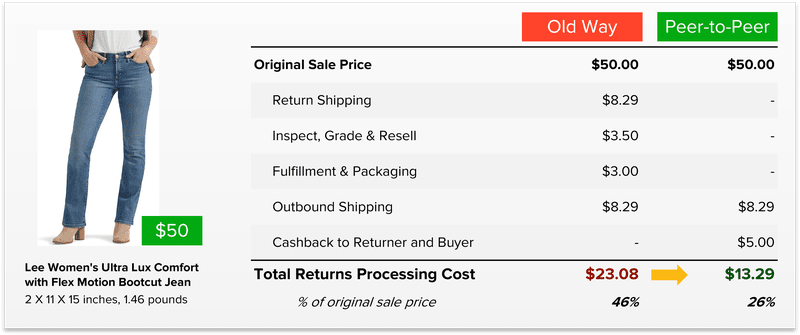Customer Returns Management: How to Use Your Returns Process to Enhance Customer Loyalty

Last updated on April 25, 2025

In this article
 13 minutes
13 minutes
- Introduction to Returns Management
- Why Returns Matter for Customer Loyalty
- Key Strategies to Use Returns Management to Enhance Customer Loyalty
- Integrating with Existing Systems
- Preventing Returns
- Case Studies: Successful Returns Management and Customer Loyalty
- Measuring Success
- Conclusion
- Frequently Asked Questions
A seamless returns process might seem like a small part of the ecommerce experience, but it has a huge impact on customer satisfaction and loyalty. In fact, allowing customers to initiate the returns process themselves can be a make-or-break factor in creating lasting, positive relationships with customers. Customer returns management is about more than just managing logistics, it’s a vital opportunity to build trust, enhance satisfaction, and foster customer loyalty.
Customers expect an easy, hassle-free returns experience, and they’ll remember how they were treated if something goes wrong. A successful returns management strategy can turn a potentially negative situation into a positive one, boosting customer satisfaction and encouraging repeat business.
In this article, we’ll explore how returns management can become a key player in your overall customer experience, offering practical strategies to help manage returns effectively while driving customer loyalty.
Introduction to Returns Management
Returns management is a critical component of any ecommerce business, playing a vital role in maintaining customer satisfaction and loyalty. The returns management process involves handling customer returns, refunds, and exchanges in an efficient and timely manner. Effective returns management processes can help businesses reduce costs, improve operational efficiency, and boost customer satisfaction. In this section, we will explore the importance of returns management and its impact on customer loyalty and business efficiency.
A well-structured returns management process is not just a logistical necessity but a strategic advantage. When customers know they can return products easily and without hassle, their confidence in your brand increases, leading to enhanced customer affinity. Moreover, efficient returns management can streamline operations, reduce unnecessary costs, and improve overall business efficiency. By focusing on creating a seamless returns experience, businesses can turn potential negative experiences into opportunities for building stronger customer relationships.
Why Returns Matter for Customer Loyalty
The returns process is an inevitable part of the online shopping experience. Customers may change their mind, receive a product that doesn’t meet their expectations, or experience sizing issues. However, how businesses handle these customer returns can make all the difference in how customers view their brand. Regularly utilizing reporting tools to analyze returns data can help identify trends, leading to informed decisions that improve product quality, customer satisfaction, and the overall shopping experience.
Understanding Customer Returns
Customer returns are an inevitable part of any ecommerce business. Understanding the reasons behind customer returns is crucial for developing an effective returns management strategy. Common reasons for customer returns include receiving the wrong item, product dissatisfaction, and issues related to size and fit. By analyzing returns data, businesses can identify trends and patterns, enabling them to make informed decisions to improve their products and services.
For instance, if a particular product is frequently returned due to sizing issues, this insight can prompt a review of the product’s sizing information or even the product design itself. Data analytics can reveal which products are most often returned and why, allowing businesses to address these issues proactively. By understanding the root causes of returns, businesses can make targeted improvements that reduce return rates.
The Customer Returns Journey
The entire process of returns management is often the last step in the customer journey, but it’s also one of the most critical moments in shaping their overall impression of your ecommerce business. If the process is complicated, confusing, or lengthy, it will likely lead to customer friction and even deter future purchases. However, if you make it easy, efficient, and transparent, you’ll not only resolve the issue but also build a stronger relationship with your customer.
Managing Returns to Improve Customer Satisfaction
Delivering a well-managed returns management program leads to a smoother experience for customers, which in turn helps boost customer satisfaction. In fact, customers who feel confident in a retailer’s returns policy are more likely to make repeat purchases. When customers expect simple, no-hassle returns, and see in advance of a purchase that you offer them, they’re more likely to trust your brand and shop with peace of mind.
Key Strategies to Use Returns Management to Enhance Customer Loyalty
1. Simplify the Returns Process
A hassle-free returns process is essential for creating a positive customer experience. The more straightforward and transparent the process, the more likely your customers are to remain loyal. Implementing an efficient returns authorization process can further simplify the return experience for customers.
Why it works: Customers appreciate clear instructions on how to return items, whether they purchased them online or in-store. A returns management system that’s easy to navigate and understand will enhance customer satisfaction and increase customer loyalty. Offering clear information about the steps involved and providing return labels or prepaid return shipping will further streamline the experience.
Pro Tip: Make your returns policy easy for customers to find on your online store. It should outline the steps clearly, including timeframes, product condition requirements, and how to get their return authorized.
2. Offer Free Returns and Store Credit
Free returns have become an expectation for many online shoppers. In fact, businesses that offer free return shipping or free returns are often viewed more favorably by customers. Offering store credit instead of refunds for returns is another powerful tool for fostering brand loyalty. When a customer is offered store credit, they’re more likely to make a future purchase and continue shopping with your business, while you retain revenue.
Why it works: By offering store credit, businesses can maintain customer loyalty while still ensuring the return is handled effectively. Customers are happy to receive store credit and continue shopping, which in turn benefits your profit margins and customer retention.
Pro Tip: Include incentives such as discounts or loyalty points for those who choose store credit instead of refunds. This can be an excellent way to increase the likelihood of future purchases while offering customers more value.
3. Automate Your Returns Management System
Automated returns management systems are key to handling returns efficiently. By integrating a returns management software or returns management automation system, you can streamline your operations, reduce manual intervention, and provide timely refunds or exchanges to customers. Automation also allows you to track return requests and returns data more effectively, helping you make smarter decisions about inventory and the return process itself. Establishing robust data management systems is essential for gathering and analyzing accurate real-time data, which can significantly improve your returns management process.
Why it works: Automation increases business efficiency and ensures consistency throughout the returns process. It also helps you identify trends in returns data, such as which products are returned most often or which customers frequently initiate returns. By using data analytics, you can make adjustments to your product offerings and reduce future returns.
Pro Tip: Look for a system that integrates well with your inventory management software and supply chain processes to ensure seamless communication across your systems. This integration can improve both your returns management and inventory management, saving time and resources.
4. Leverage Customer Feedback
Customer feedback is a powerful tool for improving the returns process and boosting customer satisfaction. Collecting feedback from customers who initiate returns can help you identify patterns, analyze the root causes of returns, and make informed decisions about future products and policies. Whether you ask customers to provide reasons for their return during the process or reach out after the return is complete, this data is invaluable for improving your returns management strategy. Analyzing this valuable data from returns management systems can enhance product quality and customer satisfaction by addressing quality issues and optimizing operations.
Why it works: Listening to customer feedback provides insights into why returns happen and how your business can adjust to meet customer expectations. For example, if customers repeatedly mention issues with product sizing, you can adjust your product listing to account for these concerns and prevent future returns.
Pro Tip: Make it easy for customers to leave feedback. Offer a simple survey or a comment box during the return process or include an option in your post-purchase emails to ask about their experience.
5. Train Your Customer Service Team to Handle Returns Proactively
A well-trained customer service team can turn a return into a positive experience. When a customer initiates a return, they often expect quick, courteous, and efficient service. By empowering your customer service representatives to resolve issues proactively and efficiently, you can improve the customer returns management process and foster positive customer relationships.
Why it works: An excellent customer service team can not only help resolve return issues quickly but also offer alternative solutions that benefit both the customer and your business. By offering exchanges or providing a discount on future purchases, your team can reduce the likelihood of losing a customer.
Pro Tip: Ensure your team is trained to handle returns with empathy and professionalism, creating a supportive and responsive customer service experience.
Integrating with Existing Systems
Effective returns management requires seamless integration with existing systems, including inventory management software, customer service platforms, and supply chain management systems. Automated returns management systems can help streamline the returns process, reducing manual errors and improving efficiency. By integrating returns management with existing systems, businesses can ensure timely and accurate payments, enhance customer satisfaction, and maintain positive customer relationships.
For example, integrating a returns management system with an inventory management system ensures that returned products are promptly restocked, keeping inventory levels accurate and reducing stockouts. This integration also allows for better tracking of return requests and more efficient processing of refunds or exchanges. By leveraging technology to create a cohesive system, businesses can enhance operational efficiency and provide a smoother, more reliable returns experience for customers.
Preventing Returns
Preventing returns is a key aspect of effective returns management. Businesses can prevent returns by providing accurate product descriptions, offering excellent customer service, and ensuring that products are properly packaged and shipped. By reducing returns, businesses can minimize costs, improve profit margins, and enhance customer satisfaction.
For instance, detailed product descriptions, high-quality images, and customer reviews can help customers make more informed purchasing decisions, reducing the likelihood of returns due to unmet expectations. Additionally, providing exceptional customer service can address any pre-purchase concerns, further decreasing the chances of returns. By focusing on these preventative measures, businesses can create a more satisfying shopping experience and reduce the operational burden of handling returns.
Case Studies: Successful Returns Management and Customer Loyalty
- Zappos: Zappos is a standout example of a company that uses its returns process to enhance customer loyalty. With its 365-day return policy and free returns, Zappos makes it easy for customers to return items, knowing they won’t be penalized for doing so. This commitment to a hassle-free returns process has contributed to Zappos’s repeat business and customer loyalty. Implementing returns management best practices has been key to their success.
- Nordstrom: Nordstrom’s exceptional customer service is well-known, particularly in handling returns. Their efficient returns management and flexible policies have helped create a loyal customer base, with many shoppers opting for exchanges instead of refunds. Nordstrom’s ability to manage returns effectively has made it a brand synonymous with customer satisfaction.
Measuring Success
Measuring the success of a returns management strategy is necessary for identifying areas of improvement and optimizing the returns process. Key performance indicators (KPIs) for measuring success include return rates, customer satisfaction ratings, and the efficiency of the returns process. By analyzing these KPIs, businesses can identify trends and patterns, enabling them to make data-driven decisions to improve their returns management processes.
For example, tracking return rates can reveal whether certain products or categories are more prone to returns, allowing businesses to investigate and address the underlying issues. Customer satisfaction ratings can provide insights into how well the returns process is meeting customer expectations. Additionally, analyzing the efficiency of the returns process can highlight areas where improvements can be made to reduce processing times and enhance the overall customer experience.
In addition to these KPIs, businesses can also use data analytics to measure the success of their returns management strategy. By analyzing returns data, businesses can identify the most returned products, the reasons for returns, and the effectiveness of their returns management processes. This information can be used to make informed decisions to improve products, services, and returns management processes, ultimately enhancing customer satisfaction and loyalty.
By implementing an effective returns management strategy, businesses can reduce costs, improve operational efficiency, and boost customer satisfaction. By understanding customer returns, integrating with existing systems, preventing returns, and measuring success, businesses can develop a successful returns management strategy that enhances customer loyalty and drives business efficiency.
Conclusion
Returns management is an essential part of your overall ecommerce strategy. When handled well, it not only resolves customer complaints but also enhances customer loyalty and boosts customer satisfaction. By offering a hassle-free returns process, free returns, store credit, and excellent customer service, you can turn returns into an opportunity to strengthen your brand and build long-lasting relationships with customers. Additionally, improving customer satisfaction through effective returns management strategies can foster brand loyalty and ultimately improve overall customer experiences.
Integrating returns management automation, analyzing returns data, and using customer feedback can further optimize the process, making it smoother and more efficient. When customers feel confident that they can easily return items with minimal effort, they’re more likely to return for future purchases, driving repeat business and customer retention.
Frequently Asked Questions
How can a seamless returns process increase customer loyalty?
A smooth and hassle-free returns process builds customer trust, as it shows that a business cares about customer satisfaction. Customers who feel supported during returns are more likely to become repeat customers.
Why should businesses offer store credit instead of cash refunds?
Offering store credit encourages customers to shop again, thereby increasing the likelihood of future purchases and building stronger brand loyalty.
How does customer feedback improve the returns process?
Customer feedback helps identify recurring issues with products or services, enabling businesses to adjust their offerings and policies to better meet customer expectations, reducing future returns.
What role does automation play in managing returns?
Automation in returns management ensures a more efficient and consistent process, reduces human error, and allows businesses to manage large volumes of returns with ease. It also helps track trends and makes future decisions more data-driven.
How can a business reduce the number of returns?
Improving product descriptions, sizing guides, and offering virtual try-ons can help customers make more informed decisions, reducing the likelihood of returns and improving customer satisfaction.
What is reverse logistics and how does it differ from returns management?
Reverse logistics encompasses a broader scope than returns management, including processes like product refurbishment, recycling, and waste management. It focuses on sustainability, value recovery, and handling the operational complexities of returned items. Efficient reverse logistics systems are crucial in today’s ecommerce environment for maximizing value and minimizing waste.

Up to 64% Lower Returns Processing Cost


